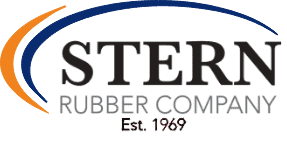This type of synthetic rubber, ethylene propylene diene monomer, or simply referred to as EPDM rubber, has uses in many different applications. This is an M-Class rubber where the M refers to its classification in ASTM standard D-1418. Ethylene is obtained from petroleum and natural gas and is a colorless, flammable, gaseous, alkene with a sweet odor. Propylene, like Ethylene, is a flammable gas that has a slight odor of petroleum and is a colorless gas, which is obtained by thermal cracking of ethylene. Diene is a hydrocarbon that contains two double bonds of carbons. Stern Rubber Company compounds and mills batches of EPDM rubber for our compression molding, transfer molding, rubber injection, rubber to metal bonding and rubber extrusion.
The origin of EPDM starts with its patent in 1967 by Everett T. McDonel, Brecksville, and Parviz Hamed, in Akron, Ohio, under contract for B.F. Goodrich. EPDM rubber has a good resistance against oxygen, ozone and inorganic and organic chemicals; it also lacks resistance to substances like grease, solvents and mineral oils. EPDM is outstanding in temperature resistance and it exhibits low temperature flexibility; EPDM rubber has a wide range of temperature range from -70⁰F to +300⁰F. What make EPDM an excellent rubber, besides from its good temperature range, is its resistance to water and seawater. In fact, EPDM is not reactive to chlorinated water, which makes it an excellent application for use in the water industry. Our largest customers at Stern Rubber Company, American Valve and Hydrant and Waterous, use gate valves manufactured of EPDM rubber.
Also, EPDM has a wide variety of application in the rubber molding industry and molded or extruded at Stern Rubber Company. EPDM also has resistance to chemicals, and solvents, rendering this rubber for uses in seals, o rings and gaskets. EPDM lends itself to working well with compression, transfer and injection molding processes, as well as the extrusion process for products like rubber hoses, electrical cables, tubing and seals. In addition, other products that work well with EPDM are washers, die cut rubber gaskets, isolators, belts, intake hoses, weather stripping, water pumps and valves. Roofing membranes are usually made of EPDM, as well as rubber sheeting for water collection and pond liners, since it simply does not contaminate the water that the rubber comes in contact with. One of the most common uses of EDPM rubber is in the automotive and vehicle markets, to reduce friction and noise this rubber is used in window seals, door seals, trunk seals and in hood seals.
